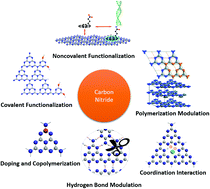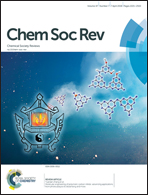Molecular engineering of polymeric carbon nitride: advancing applications from photocatalysis to biosensing and more
Abstract
As a promising two-dimensional (2D) conjugated polymer, polymeric carbon nitride (CN) is attracting dramatically increasing interest due to its unusual properties, facile synthesis from abundant and inexpensive starting materials, and promising applications ranging from (photo)catalysis, and photoelectrochemistry, to biosensors. The polymeric feature and facile synthesis of CN allow easy engineering of its structure at the molecular level. For instance, the moderate reactivity of CN at the interface, together with the aromatic π-conjugated framework and intralayer hydrogen bonds, provides ample possibilities to control its molecular structure and properties to meet task-specific applications. This review summarizes and highlights a panorama of the latest advancements related to the design and construction of the molecular structure of CN, such as by doping and copolymerization, engineering of the polymerization degree, coordination interaction, covalent and noncovalent functionalization, and modulation of intralayer hydrogen bonding. Beyond photocatalysis, the emerging applications of CN are also briefly discussed with a special emphasis on sensing, bioimaging and biotherapy, smart responsive systems and photoelectrochemical devices. This review ends with perspectives on the challenges and future prospects of molecular engineering of CN.



 Please wait while we load your content...
Please wait while we load your content...